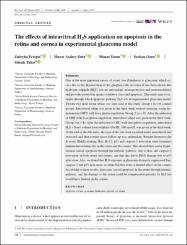| dc.contributor.author | Erişgin, Züleyha | |
| dc.contributor.author | Özer, Murat Atabey | |
| dc.contributor.author | Tosun, Murat | |
| dc.contributor.author | Özen, Serkan | |
| dc.contributor.author | Takir, Selçuk | |
| dc.date.accessioned | 2022-06-06T11:36:23Z | |
| dc.date.available | 2022-06-06T11:36:23Z | |
| dc.date.issued | 2019 | en_US |
| dc.identifier.citation | Erisgin, Z., Ozer, M. A., Tosun, M., Ozen, S., & Takir, S. (2019). The effects of intravitreal H2S application on apoptosis in the retina and cornea in experimental glaucoma model. International Journal of Experimental Pathology, 100(5-6), 330-336. | en_US |
| dc.identifier.issn | 1365-2613 | |
| dc.identifier.uri | https://doi.org/10.1111/iep.12334 | |
| dc.identifier.uri | https://hdl.handle.net/20.500.12933/1130 | |
| dc.description.abstract | One of the most important causes of visual loss (blindness) is glaucoma, which occurs due to the degeneration of the ganglion cells in retina. It has been shown that hydrogen sulphide (H2S) acts an antioxidant, neuroprotective and neuromodulator and provides protection against oxidative stress and apoptosis. This study aims to examine through which apoptotic pathway H2S acts in experimental glaucoma model. Twenty-two male wistar albino rats were used in this study. Group 1 (n = 6, control group): Intravitreal saline was given in the third week without inducing ocular hypertension (OHT) with laser photocoagulation. Group 2 (n = 8): After the induction of OHT with laser photocoagulation, intravitreal saline was given in the third week. Group 3 (n = 8): After the induction of OHT with laser photocoagulation, intravitreal H2S's donor sodium hydrosulphide (NaSH) 100 nmol/L was given in the third week. At the end of the 6th week, the eyes of the rats were sacrified under anaesthesia and extracted and then routine tissue follow-up was undertaken. Besides haematoxylin & eosin (H&E) staining, Bax, Bcl-2, p53 and caspase-3 activation were examined immunohistochemically in the retina and the cornea. This showed that ocular hypertension caused apoptosis through the intrinsic pathway, due to Bax and caspase-3 activation, in both retina and cornea, and that this led to DNA damage due to p53 activation. Also, we found that H2S exposure in glaucoma distinctly suppressed Bax, caspase-3 and p53 activations in retina but that it has a limited effect on the cornea. According to these results, glaucoma caused apoptosis in the retina through intrinsic pathway, and the damage to the retina could be compensated partially by H2S but would have limited on the cornea. | en_US |
| dc.language.iso | eng | en_US |
| dc.publisher | Wiley | en_US |
| dc.relation.isversionof | 10.1111/iep.12334 | en_US |
| dc.rights | info:eu-repo/semantics/openAccess | en_US |
| dc.subject | Apoptosis | en_US |
| dc.subject | Cornea | en_US |
| dc.subject | Glaucoma | en_US |
| dc.subject | Hydrogen sulphide | en_US |
| dc.subject | Rat | en_US |
| dc.subject | Retina | en_US |
| dc.title | The effects of intravitreal H2S application on apoptosis in the retina and cornea in experimental glaucoma model | en_US |
| dc.type | article | en_US |
| dc.authorid | 0000-0001-9673-9771 | en_US |
| dc.department | AFSÜ, Tıp Fakültesi, Temel Tıp Bilimleri Bölümü, Histoloji ve Embriyoloji Ana Bilim Dalı | en_US |
| dc.contributor.institutionauthor | Tosun, Murat | |
| dc.identifier.volume | 100 | en_US |
| dc.identifier.issue | 5-6 | en_US |
| dc.identifier.startpage | 330 | en_US |
| dc.identifier.endpage | 336 | en_US |
| dc.relation.journal | International Journal of Experimental Pathology | en_US |
| dc.relation.publicationcategory | Makale - Uluslararası Hakemli Dergi - Kurum Öğretim Elemanı | en_US |
















